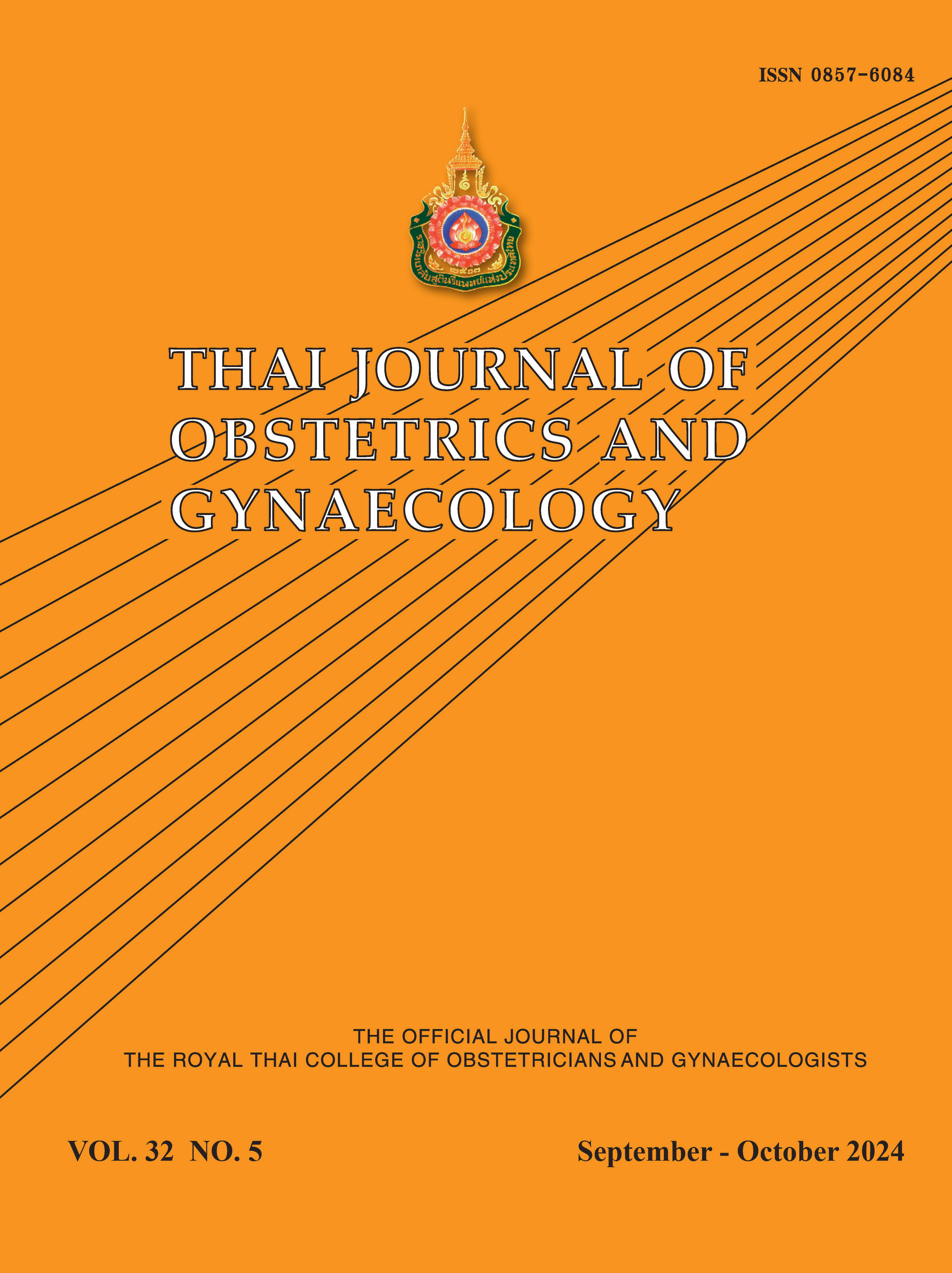Surgical Outcomes of Laparoscopic High Uterosacral Vaginal Vault Suspension for Apical Prolapse Repair
Main Article Content
Abstract
Objectives: To evaluate surgical outcomes of laparoscopic high uterosacral ligament suspension (HUSLS) for apical prolapse repair in terms of success rates, perioperative complications, and the ability to perform concomitant bilateral salpingectomy/salpingo-oophorectomy.
Methods: This is a retrospective study of women diagnosed with stage II-IV uterovaginal prolapse who had undergone laparoscopic HUSLS for apical prolapse repair at Department of Obstetrics and Gynecology, Phramongkutklao Hospital between January 2017 and September 2020. Patients’ baseline characteristics, clinical presentation, pre- and post-operative prolapse stage and location, pre- and post-operative POP-Q measurements, perioperative complications, and feasibility of opportunistic salpingectomy/salpingo-oophorectomy were collected and analyzed.
Results: Of 40 patients enrolled, mean age was 62.33±7.49 years, whereas mean body mass index was 24.7±3.2 kg/m2. Most were postmenopausal (92.5%) and presented with bulge symptom (97.5%). Thirty-five (87.5%) patients were diagnosed with advanced stage prolapse. All underwent hysterectomy prior to laparoscopic HUSLS. Additional procedures comprised anterior colporrhaphy (42.5%), posterior colporrhaphy (70%), perineorrhaphy (50%), and midurethral sling (5%). Bilateral salpingo-oophorectomy was performed in all patients. Mean operative time for all procedures was 3.1±0.8 hours, whereas median blood loss was 50 milliliters. No major perioperative complications, including ureteric injury, were encountered. High anatomical success of 90% was achieved at 12-month F/U with significant improvement in all POP-Q measurements, except PB and TVL. Of 4 patients with recurrent prolapse, 3 later underwent total colpocleisis, whereas 1 required anterior vaginal mesh repair.
Conclusion: Laparoscopic HUSLS is a safe and effective procedure for apical prolapse repair without major perioperative complications when performed in the hands of experts.
Article Details

This work is licensed under a Creative Commons Attribution-NonCommercial-NoDerivatives 4.0 International License.
References
Haylen BT, Maher CF, Barber MD, Camargo S, Dandolu V, Digesu A, et al. An International Urogynecological Association (IUGA)/International Continence Society (ICS) joint report on the terminology for female pelvic organ prolapse (POP). Int Urogynecol J 2016;27:655-84.
Maglinte DD, Kelvin FM, Fitzgerald K, Hale DS, Benson JT. Association of compartment defects in pelvic floor dysfunction. Am J Roentgenol 1999;172:439-44.
Hall AF, Theofrastous JP, Cundiff GW, Harris RL, Hamilton LF, Swift SE, et al. Interobserver and intraobserver reliability of the proposed International Continence Society, Society of Gynecologic Surgeons, and American Urogynecologic Society pelvic organ prolapse classification system. Am J Obstet Gynecol 1996;175:1467-71.
Summers A, Winkel LA, Hussain HK, DeLancey JO. The relationship between anterior and apical compartment support. Am J Obstet Gynecol 2006; 194:1438-43.
Diwadkar GB, Barber MD, Feiner B, Maher C, Jelovsek JE. Complication and reoperation rates after apical vaginal prolapse surgical repair: a systematic review. Obstet Gynecol 2009;113:367-73.
Ashton-Miller JA, DeLancey JO. Functional anatomy of the female pelvic floor. Ann N Y Acad Sci 2007;1101: 266-96.
Rondini C, Braun H, Alvarez J, Urzúa MJ, Villegas R, Wenzel C, et al. High uterosacral vault suspension vs sacrocolpopexy for treating apical defects: a randomized controlled trial with twelve months follow-up. Int Urogynecol J 2015;26:1131-8.
Margulies RU, Rogers MA, Morgan DM. Outcomes of transvaginal uterosacral ligament suspension: systematic review and metaanalysis. Am J Obstet Gynecol 2010;202:124-34.
Falconer H, Yin L, Gronberg H. Ovarian cancer risk after salpingectomy: a nationwide population-based study. J Natl Cancer Inst 2015;107:1-6.
Houlihan S, Kim-Fine S, Birch C, Tang S, Brennand EA. Uterosacral vault suspension (USLS) at the time of hysterectomy: laparoscopic versus vaginal approach. Int Urogynecol J 2019;30:611-21.
Rardin CR, Erekson EA, Sung VW, Ward RM, Myers DL. Uterosacral colpopexy at the time of vaginal hysterectomy: comparison of laparoscopic and vaginal approaches. J Reprod Med 2009;54:273-80.
Barber MD, Brubaker L, Nygaard I, Wheeler TL 2nd, Schaffer J, Chen Z, Spino C; Pelvic Floor Disorders Network. Defining success after surgery for pelvic organ prolapse. Obstet Gynecol 2009;114:600-9.
Lensen EJ, Withagen MI, Kluivers KB, Milani AL, Vierhout ME. Urinary incontinence after surgery for pelvic organ prolapse. Neurourol Urodyn 2013;32: 455-9.
Ugianskiene A, Kjærgaard N, Inger Lindquist AS, Larsen T, Glavind K. Retrospective study on de novo postoperative urinary incontinence after pelvic organ prolapse surgery. Eur J Obstet Gynecol Reprod Biol 2017;219:10-4.
Srikureja N, Hengrasmee P, Leerasiri P, Asumpinwong C. Urinary symptoms and urodynamic findings before and after vaginal surgery for pelvic organ prolapse. Urogynaecologia 2021;33:1-6.
Lowder JL, Park AJ, Ellison R, Ghetti C, Moalli P, Zyczynski H, et al. The role of apical vaginal support in the appearance of anterior and posterior vaginal prolapse. Obstet Gynecol 2008;111:152-7.
Rooney K, Kenton K, Mueller ER, FitzGerald MP, Brubaker L. Advanced anterior vaginal wall prolapse is highly correlated with apical prolapse. Am J Obstet Gynecol 2006; 195:1837-40.


